
The Red Line is a rapid transit line operated by the Massachusetts Bay Transportation Authority (MBTA) as part of the MBTA subway system. The line runs south and east underground from Alewife station in North Cambridge through Somerville and Cambridge, surfacing to cross the Longfellow Bridge then returning to tunnels under Downtown Boston. It continues underground through South Boston, splitting into two branches on the surface at JFK/UMass station. The Ashmont branch runs southwest through Dorchester to Ashmont station, where the connecting light rail Ashmont–Mattapan High Speed Line continues to Mattapan station. The Braintree branch runs southwest through Quincy and Braintree to Braintree station.
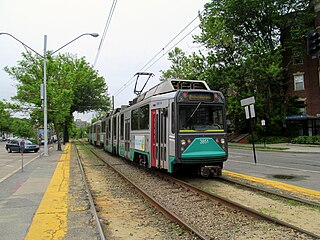
The Green Line is a light rail system run by the Massachusetts Bay Transportation Authority (MBTA) in the Boston, Massachusetts, metropolitan area. It is the oldest Boston rapid transit line, and with tunnel sections dating from 1897, the oldest subway in North America. It runs underground through downtown Boston, and on the surface into inner suburbs via four branches on several radial boulevards. With an average daily weekday ridership of 137,700 in 2019, it is the third most heavily used light rail system in the country. The line was assigned the green color in 1967 during a systemwide rebranding because several branches pass through sections of the Emerald Necklace of Boston.
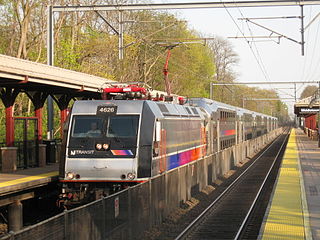
The North Jersey Coast Line is a commuter rail line running from Rahway to Bay Head, New Jersey, traversing through the Jersey Shore region. Operated by New Jersey Transit, the line is electrified as far south as Long Branch. On rail system maps it is colored light blue, and its symbol is a sailboat. The line runs along the former New York & Long Branch Railroad, which was co-owned by the Central Railroad of New Jersey and the Pennsylvania Railroad.

The B branch, also called the Commonwealth Avenue branch or Boston College branch, is a branch of the MBTA Green Line light rail system which operates on Commonwealth Avenue west of downtown Boston, Massachusetts. One of four branches of the Green Line, the B branch runs from Boston College station down the median of Commonwealth Avenue to Blandford Street. There, it enters Blandford Street portal into Kenmore station, where it merges with the C and D branches. The combined services run into the Boylston Street subway and Tremont Street subway to downtown Boston. B branch service has terminated at Government Center since October 2021. Unlike the other branches, the B branch runs solely through the city limits of Boston. The Green Line Rivalry between Boston College and Boston University is named in reference to the B branch, which runs to both universities.

The D branch of the Massachusetts Bay Transportation Authority (MBTA) Green Line, also known as the Highland branch or the Riverside Line, is a light rail line in Boston and the adjacent suburbs of Brookline and Newton. It runs on a grade separated surface right-of-way for 9 miles (14 km) from Riverside station to Fenway station, then shares the Boylston Street Subway and Tremont Street Subway with the other Green Line branches, with a terminus at North Station in downtown Boston. It is the longest and busiest of the four Green Line branches.

The Franklin Line, part of the MBTA Commuter Rail system, runs from Boston's South Station in a southwesterly direction toward Franklin, Massachusetts, utilizing the Northeast Corridor before splitting off onto the namesake Franklin Branch. Most Franklin Line trains connect to the Providence/Stoughton Line at Readville, though some weekday trains use the Dorchester Branch to access South Station. Most weekday trains, and all weekend trains, bypass Hyde Park. Several weekday trains originate at Norwood Central or Walpole.

Port Glasgow railway station is on the Inverclyde Line, serving the town of Port Glasgow, Scotland. It is located in the town centre with the main entrance at the junction of Princes Street and John Wood Street.
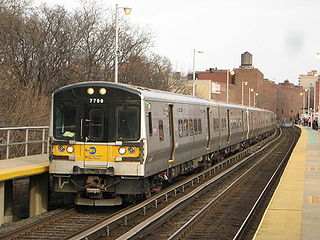
The Port Washington Branch is an electrified two-track rail line and service owned and operated by the Long Island Rail Road in the U.S. state of New York. It branches north from the Main Line at the former Winfield Junction station, just east of the Woodside station in the New York City borough of Queens, and runs roughly parallel to Northern Boulevard past Mets-Willets Point, Flushing, Murray Hill, Broadway, Auburndale, Bayside, Douglaston, Little Neck, and then crosses into Nassau County for stops in Great Neck, Manhasset, and Plandome before terminating at Port Washington.

The Needham Line is a branch of the MBTA Commuter Rail system, running west from downtown Boston, Massachusetts through Roxbury, Jamaica Plain, Roslindale, West Roxbury, and the town of Needham. The second-shortest line of the system at just 13.7 miles long, it carries 8,218 daily riders. Unlike the MBTA's eleven other commuter rail lines, the Needham Line is not a former intercity mainline; instead, it is composed of a former branch line, a short segment of one intercity line, and a 1906-built connector.

Bay Street is a New Jersey Transit station on Pine Street between Bloomfield and Glenridge Avenues in Montclair, New Jersey, along the Montclair-Boonton Line. The station is served by all trains on the line, including all ten weekend trains. The first station of six in Montclair, Bay Street is the southernmost, servicing the downtown district. The station was built originally in 1981 to replace the Lackawanna Terminal built near Grove Street in 1913 as a part of creating the Montclair Connection. Upon its opening on February 27, 1981, Bay Street was a lone platform with a single shelter. In 2002, as part of the Montclair Connection, Bay Street was completely rebuilt to standards for ADA accessibility, including two high-level platforms and a new elevator for a bridge crossing the tracks. The station also received honors in July 2010 for the development around the station and as a result was a part of getting Montclair designated a Transit Village, by the New Jersey Department of Transportation, under the Transit Village Initiative.

The Providence/Stoughton Line is an MBTA Commuter Rail service in Massachusetts and Rhode Island, primarily serving the southwestern suburbs of Boston. Most service runs entirely on the Northeast Corridor between South Station in Boston and Providence station or Wickford Junction station in Rhode Island, while the Stoughton Branch splits at Canton Junction and terminates at Stoughton. It is the longest MBTA Commuter Rail line, and the only one that operates outside Massachusetts. The line is the busiest on the MBTA Commuter Rail system, with 25,728 daily boardings by a 2018 count.
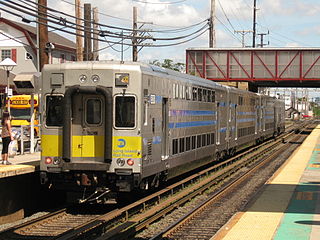
The Oyster Bay Branch is a rail line and service owned and operated by the Long Island Rail Road in the U.S. state of New York. The branch splits from the Main Line just east of Mineola station, and runs north and east to Oyster Bay. The branch is electrified between East Williston and Mineola.
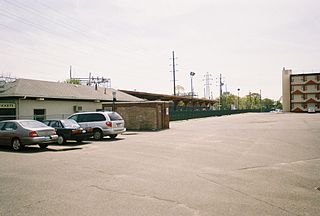
The West Hempstead Branch is an electrified rail line owned and operated by the Long Island Rail Road (LIRR) in the U.S. state of New York. It runs between Valley Stream, New York, and West Hempstead, New York.

Mineola is a station on the Main Line of the Long Island Rail Road in the village of Mineola, New York. All trains for the Port Jefferson, Ronkonkoma, and Oyster Bay branches run through this station, as well as a few for the Montauk Branch. As of May 2011, 145 trains stop at this station every weekday, more than any other station east of Jamaica. It is the eighth-busiest station on the LIRR in terms of weekday boardings, with 10,348 boardings per day in 2006.
The Toronto Branch Railway Line is a closed railway line in New South Wales, Australia. The line opened in 1891, and branched off the Main Northern line at Fassifern station, crossing over a single lane tunnel on Fassifern Road, and following the shore of Fennell Bay to Blackalls Park. The Toronto end of the line is located close to the shore of Toronto Bay.

Amory Street station is a light rail stop on the Massachusetts Bay Transportation Authority (MBTA) Green Line B branch, located in the median of Commonwealth Avenue in the west part of the Boston University campus. The accessible station has two side platforms serving the line's two tracks, with access at Amory Street and St. Paul Street.
Collywell Bay was a railway station constructed in 1913–14 to serve a planned branch line terminating at Seaton Sluice. Although the line was built, the station did not open and the branch line was abandoned in 1931. The station was demolished in 1964 and remained in place despite never being opened. The station was to have been the terminus of the never opened Collywell Bay Branch Line, which, intending to promote Seaton Sluice as a resort, chose a more appealing name for their line and station.
Brierdene was to have been a railway station on the Collywell Bay Branch Line and construction began in 1913 and was abandoned in 1914. The station was to have had 2 platforms and served by the North Eastern Railway.
Seaton Sluice was a "station" on the wagonway from Hartley Pit at its terminus in the village of Seaton Sluice. The "station" was served intermittently by passenger trains between 1 May 1851 and April 1853 and wagonway, itself, was abandoned in the 1860s.
The Glasson Dock Branch Line was a railway line in Lancashire, England. Opened in 1883, this 5-mile branch line connected Glasson Dock to the UK rail network at Lancaster, with stations at Glasson Dock, Conder Green and at a private halt, Ashton Hall railway station. Passenger and freight services were provided, and its success came from transporting goods from the dock at Glasson and from St Georges Quay in Lancaster.














